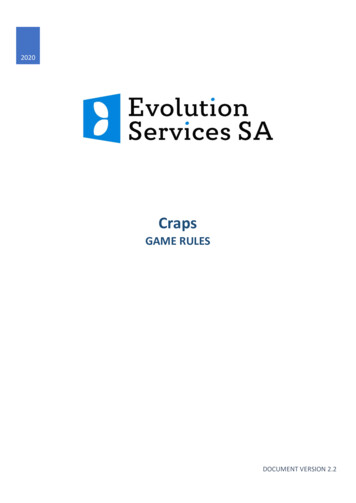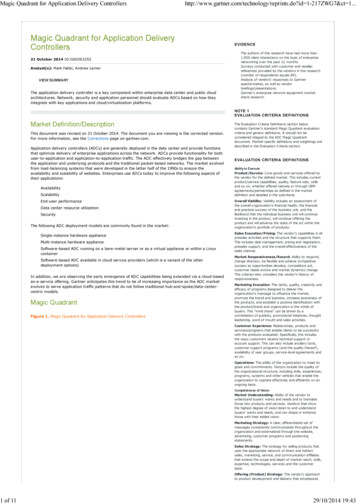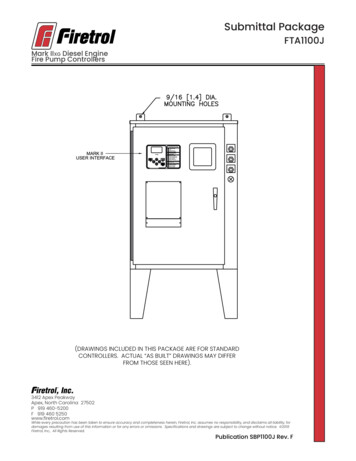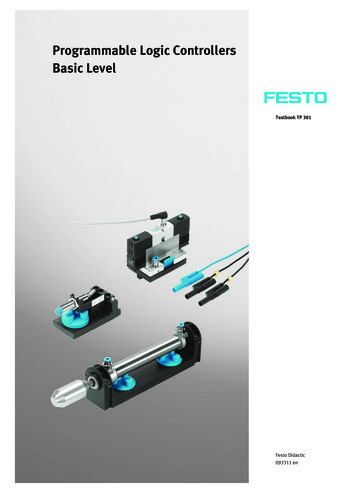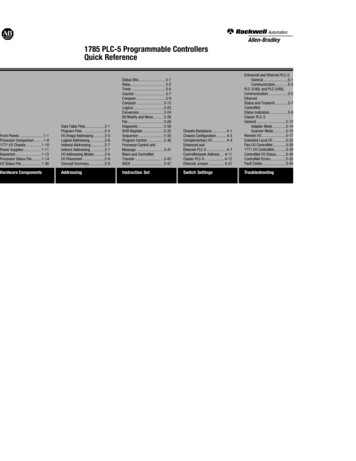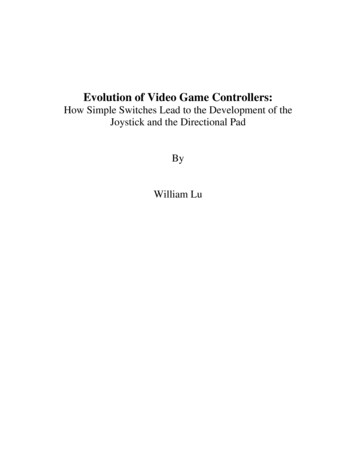
Transcription
Evolution of Video Game Controllers:How Simple Switches Lead to the Development of theJoystick and the Directional PadByWilliam Lu
INTRODUCTIONThroughout the history of video games, one of the most important aspects ofconsole video games is the controller. This piece of hardware is the one with which theplayers interact the most and is by far the most memorable component. Hours upon hoursare spent learning the intricacies of the controller – the location of the various buttons, thedistance between the buttons for the most efficient button presses, and the subtlety ofpushing the buttons just right so that the desired operation is performed – to finallymaster it. When used correctly, the controller provides an immersing experience wherethe controls are mere extensions of the player’s thoughts; however, when usedincorrectly, the controller becomes the most frustrating aspect of video games, elicitinganger and frustration. Failures in video games are often attributed to the controller forfailing to do what the player wanted to do. Countless controllers have suffered the fate ofbeing martyrs as they are smashed or thrown due to player frustration.
Figure 1: Video game controllers as a source of anger and frustration. Video gamecontrollers serve as the whipping boy for players taking out their anger and frustration.Of note is how each controller embodies the essence of the particular console in players’memories. In each case, the controller is as memorable as the particular console, if noteven more so. (Krahulik and Holkins, Penny Arcade)The design of a video game controller should not be taken lightly. Aside fromremoving the barrier between the player and the virtual environment, the controller alsospecifies the type of experience the player will have by defining what types of games arebest played on it due to its design. For example, the Nintendo GameCube controller hasalready developed a reputation for being bad for fighting games due to its button layout,which discourages button mashing, whereas the Microsoft Xbox controller, with itsshoulder triggers that mimic actual triggers, has become a favorite for first personshooters, which contributes to the success of the popular first-person shooter Halo on theXbox. (Takahashi, Opening the Xbox)Despite the importance of video game controllers, it is the most neglected aspectof video games. Most histories on video game consoles describe the components that gointo the generic black boxes – which generally resemble a video cassette recorder (VCR)– with merely a paragraph on how the designers developed the controllers. Only untilrecently has the focus shifted towards more user testing in the design process toemphasize the importance of the video game controller. Prior to this, controllers mainlydeveloped as designers tried to cope with the challenges of the particular consoleproblems such as avoiding damage to expensive equipment or coherently organizingcomplicated buttons. To understand the process that led to the design of today’s videogame controllers as well as why certain controller elements have been universally
adopted, one must examine the history of video game controllers. Only then can we hopeto develop better controllers.SPACEWAR: THE ORIGINLike most other aspects of video games, the controller traces its origin all the wayback to Spacewar, arguably the first video game.1 Spacewar was the brainchild of SteveRussell and his cohorts Wayne Witanen and J. Martin Graetz. The group was inspired bythe Skylark and Lensmen series of novels by Edward E. Smith, PhD., which featuredscience fiction heroes who “had a strong tendency to get pursued by the villain across thegalaxy and have to invent their way out of their problem while they were being pursued.”(Triplanetary, 1948 as cited by Rollingstone, 1972) In the strictest sense, Spacewar was aspace combat game in which players controlled different spaceships and tried to destroyeach other while avoiding enemy fire by firing torpedoes and maneuvering their ships.Originally envisioned as a demonstration of the computing power of MIT’s newTX-0, Spacewar was finally developed on a PDP-1 that was installed next door in 1961.In the original Spacewar, ships were controlled with four of the eight Test Word switcheson the PDP-1. The switches determined whether the ship turned left, turned right,whether the rocket was on, and whether torpedoes were being fired. (Net Memories ofSpacewar, 1994) “‘You had four controls,’ Russell recalls, ‘rotate counterclockwise,rotate clockwise, turn on your rocket thrust, which caused a little tail of rocket exhaust to1Joystick Nation and L’Univers des jeux video both erroneously attribute Spacewar as the first video game;however, as explained by Trigger Happy and Phoenix: The Fall and Rise of Videogames, the first videogame was developed by William A. Higinbotham at the Brookhaven National Laboratory in 1958.(Rosenthal, Fun With an Oscilloscope) Higinbotham was trying to develop an entertaining exhibit forvisiting members of the public. To that end, he developed a rudimentary tennis game featuring bouncingballs on an oscilloscope that were controlled by a button and a knob. The game never left the laboratoryand Higinbotham never patented it as he thought “the whole idea so obvious that it never occurred to me tothink about a patent.” (Poole, Trigger Happy and Herman, Phoenix: The Fall and Rise of Videogames)
show on the screen, and torpedo.’” (Herz, Joystick Nation) This immediately ran intoproblems. Playing Spacewar this way meant that one player always had the advantagesince the screen of the PDP-1 was to one side of the switches. (Spacewar) Also, the tableupon which the switches stood was at an inconvenient height so that after periods of play,the players’ elbows often got tired. (Herz, Joystick Nation) Further, there was always therisk of damage to the expensive equipment, and if the player is not careful, he can easilyhit the start switch by mistake and shutdown the entire computer. (Graetz, The Origin ofSpacewar!) Finally, having four switches lined up next to each other on the switchboardmeant that players had to memorize what each of the switches did. There was no naturalmapping between the location of the switches and the function of the switches. As aresult, Spacewar was game for expert players, who had the advantage over novices. Inorder to solve all of these problems, control boxes were developed for Spacewar, givingbirth to the first video game controllers.
Figure 2: The PDP-1 Spacewar was originally developed on. Spacewar was originallydeveloped on a PDP-1 similar to that pictured here. Note how the oscilloscope screen(left) is to one side of the switches (right) leading to an advantage for one player and theneed to develop control boxes. (Game On Exhibition @ Barbican Gallery, London,29.8.2002)Using their knowledge as members of the Tech Model Railroad Club, Alan Kotokand Robert A. Saunders developed the first Spacewar control box. The boxes featuredtwo double-throw switches and a button. The double-throw switches controlled therotation of the spaceship as well as the acceleration. The button determined whether atorpedo was fired. Contrary to what the controllers seemed like, these controllers did notfeature a joystick, which was not available until later. (Graetz, The Origin of Spacewar!)The throw-able switches were in fact only switches, which turned on when they werethrown to either side, but turned off when they are left in the center. There was no
relative difference in how far the switch was thrown, the switches were either on or off –that is, they were digital. Conveniently, the first MIT boxes positioned the switches sothat the double-throw switch that controlled the left and right turns of the ship washorizontal and the double-throw switch that fired the rocket to accelerate the ship wasvertical. This solved the problem of having to remember what each of the switches didsince the switches were in the same direction the ship would move, relatively. With thesenew control boxes, players could be fairly separated from the PDP-1 screen withoutendangering the equipment or giving either player an unfair advantage.Figure 3: A sketch of the original control box ofSpacewar. As described by J. M. Graetz in The Originof Spacewar!:The box is wood with a Bakelite top. The two switchesare double-throw; the button is a silent momentaryswitch. Their functions are as follows:a. Rotation control – It is pushed to the left to rotatethe ship counterclockwise, to the right to rotateclockwise.b. A two-function control – Pulled back it is the rocketaccelerator; the rocket continues to blast as long asthe switch is thrown. Pushed forward, the switch isthe hyperspace control, as described below.c. The torpedo button – It had to be silent so that youropponent could not tell when you were trying tofire. (There was a fixed delay between shots "toallow the torp tubes to cool" and fire was notautomatic; you had to keep pushing the button to getoff a missile.)As Spacewar proliferated around the country, spreading to university computersof the time, numerous different designs for the control boxes sprang up. Variationsincluded buttons for all 5 functions (right rotation, left rotation, accelerate, hyperspace,and fire) implemented by momentary switches or banks of eight switches that allowedplayers to control the ships much like they did on the original PDP-1. (Yasaki,Computing at Stanford) These control boxes were the first generation of button-based
controllers that proliferated into early arcades of the time, which offered multiple buttonsthat controlled the elements on the screen.
Figure 4: Early arcades featured button-based controls. Computer Space, an earlyarcade version of Spacewar, featured button-based controls reminiscent of its ancestor.(Game On Exhibition @ Barbican Gallery, London, 29.8.2002)ATARI AND THE JOYSTICKWith the advent of switch-based buttons, the joystick was soon to follow. Thebasic design of a generic joystick is quite simple. For a joystick to function, it merelyneeds to have four different switches, each corresponding to a different direction.(Engdal, Joystick Documents) When the stick is moved in a particular direction, a tinymetal disc makes a connection with the circuit board turning the switch on and generatingan electrical signal that indicates that the joystick was moved in a particular direction. Anadditional switch can be added to control firing. (Harris, How Joysticks Work) Joysticksbased on this design in which the switches were either on or off were the so called digitaljoysticks.Figure 5: A simple circuit diagram for a basic joystick. A basic joystick can easilyimplemented with four switches, each of which turned on (closed the circuit so that acurrent would flow) when the stick is moved in the appropriate direction. (Engdal, Digitaljoystick connector pinouts)
Despite the simplicity of the basic joystick, most modern day joysticks evolvedfrom a different ancestor. For the history of this development, it is necessary to focus onanother trend of the 60s. Following Spacewar, button-based controllers persisted;however, another totally different video game was quickly gaining popularity. That gamewas Pong. Pong dates back to Higinbotham’s “Tennis for Two” in 1958. (Rosenthal, FunWith an Oscilloscope) Magnavox also made a version with the Odyssey; however, Pongdid not really take off in popularity until the version by Al Alcorn and Atari since it wasAtari who popularized home video games. Pong was a simple arcade game in which a doton the screen bounces back and forth between two paddles. Like tennis, points werescored when your opponent couldn’t return the ball. Originally developed by Al Alcornas a training exercise before working on Computer Space, Pong did so well as its ownarcade game that it spawned a franchise of its own. (Al Alcorn Interview)Figure 6: The paddle controller. The paddle controller was arequisite for home consoles due to the popularity of Pong. (AtariHome Pong)Since its birth, the paddles on Pong have been controlled using potentiometers,which were little knobs that, when turned, moved the paddle up and down on the screen.Due to the immense popularity of Pong, the first few Atari home consoles shipped to playPong featured the de facto paddle controller. (AtariAge, Atari 2600 History) The paddlecontroller was unique in that it featured two potentiometers on two different halves of one
big controller board so that one controller allowed two people to play. (Cassidy,Warlords) The importance of Pong in the home console market heavily influenced thedesign of home console controllers.In the midst of the Pong frenzy, Fairchild Camera and Instrument released theChannel F in 1976. It was known as the Video Entertainment System (VES) and retailedfor about 170. (Hunter, Player 3: Home Systems) While offering other buttons to controldirection like up, down, left, and right, the VES controller felt the pressure of Pong andoffered a twistable top that allowed the player to turn the controller top to the left or theright. All of this was packaged in a dynamite detonator-like controller. (Dyer and Webb,Fairchild Channel F Faq) This detonator-like controller was a sufficient departure fromthe paddle controllers of its time and featured a central shaft and rotational elements thatwas influential in the design of the Atari 2600 joystick a year later.Figure 7: Channel F. The detonator-likecontroller of the Channel F and thetwistable top shows a gradual evolution tothe joystick of the Atari 2600. (Hunter,Player 3: Home Systems)The invention of the first joystick that consisted of a central shaft and a pivotalpoint is credited to Stephen D. Bristow. By 1978, when Bristow received the patent for
the Atari joystick, there were many other designs for joysticks. In part, this was due to thesimplicity with which a crude joystick can be made as mentioned above. What separatedthe Atari joystick was that it consisted of a central shaft that pivoted to make theconnections to give the five directions (up, down, left, and right) and a fire button. (Yungand Hsu, Journey to the Joystick) In its design, the departure from the paddle controllercontinued the trend started by the VES controller. The pivotal rotation was similar to thetwistable top in using rotational elements in controller design. In 1977, Atari offered theAtari joystick along with the de facto paddle controller for Pong with its Atari 2600Video Computer System (VCS), thereby giving birth to the first joystick on a video gameconsole.
Figure 8: The original joystick patent awarded to Stephen D. Bristow of Atari. (U.S.Patent Office)
NINTENDO AND THE DIRECTIONAL PAD (D-PAD)From the joystick, the development of the directional pad was a necessary stepbackwards in controller evolution. In order to understand the development of thedirectional pad, a brief history of Nintendo is necessary. Nintendo Koppai was found inMeiji 22 (1889) by Fusajiro Yamauchi to produce and sell handmade hanafuda cards.2 In1959, following a successful licensing agreement with Disney to produce playing cards,Nintendo officially became NCL – Nintendo Company, Ltd. – and the company sought tobranch out into new businesses. One of the people hired during this period of expansionwas Gunpei Yokoi. Yokoi was originally hired to maintain the assembly-line machinesthat made the playing and hanafuda cards, but was transferred into the engineeringdepartment several months later to make something for Nintendo to sell for Christmas.For this project, Yokoi developed Nintendo’s first toy, the Ultra Hand, which is a gropingextension of the hand that solidified Yokoi’s position as he continued to developNintendo’s Ultra line of toys, with more engineers added to his department.Yokoi continued to develop toys, tinkering with electronics and oscilloscopes inhis spare time. With the miniaturization of electronics and the growing influence of videogame machines in the 70s, Nintendo sought to branch into this new industry. In 1977,Nintendo had already entered the market with the Color TV Game 6, which played sixversions of Pong-like tennis. It was followed by the Color TV Game 15; however,Hiroshi Yamauchi, the president of Nintendo, wanted to go in a different direction andpressured Yokoi and his engineers to think of new ways of making video games. Inspired2Hanafuda cards consisted of forty-eight cards in a deck and were painted with a scheme of symbols like adeer, the wind, a chrysanthemum, a boar, or the moon. A popular game played with these cards is matchingflowers, which was a simple game requiring that the images be matched in pairs. (Scheff, Game Over)
by the miniaturization of electronic calculators, Yokoi sought to take advantage of thistechnology. (Game Over, 1993) What Nintendo came up with was a game called Game &Watch in 1980. (History of Nintendo)Figure 9: Game & Watch. Game & Watch was the Nintendo video game that led to thedevelopment of the directional pad. (Cuciz, Total Control – A History of GameControllers)Initially, Game & Watch consisted of a digital clock, alarm, and a gamecontrolled by two switches that moved left or right. The game soon became morecomplex and required four directions. Since it wasn’t feasible to put a joystick-likecontrol on the small game unit, it was decided that a switch would be placed for eachdirection. This arrangement, however, made the game awkward since it faced the sameproblem as the original Spacewar of not being clear which switch controlled whichdirection. To solve this awkwardness, Yokoi came up with the solution of developing“cross-shaped, thumb-operated, micro-switched lever capable of moving in fourdirections and addressing up to eight.” (Cuciz, Total Control – A History of GameControllers) Thus, the directional pad, or D-pad, was born.The direction pad was eventually incorporated into a video game console withNintendo’s launch of the Famicom, which is known as the Nintendo Entertainment
System (NES) in the United States. Following Game & Watch, Nintendo branched intoproducing a series of coin-operated arcade games, including Donkey Kong. Whilemaking coin-op games, Yamauchi was inspired by the home computer systems that wereemerging and the potential of a computer system disguised as a toy – a so called TrojanHorse that could penetrate the home market. While most machines on the market at thetime cost between 200 to 350, Yamauchi wanted a system less than 75, and had to bebetter with more features than all the other systems. To save money on selling what isessentially a computer, all of the frills were eliminated including the keyboard, themodem, and the disk drive. Removing the keyboard meant that there needed to be anotherway for the player to communicate with this computer. The solution to this problembecame the Nintendo controller featuring two buttons on the right controller with adirectional pad. With the inclusion of the NES controller, the directional pad was firmlyestablished in the history of video game consoles. (Game Over, 1993)Figure 10: Nintendo NES controller featuring the directional pad. The original NEScontroller continues the legacy started by the Game & ages/nintendo nes-004.jpg)MODERN CONTROLLERS
Since the introduction of Sony’s PlayStation dual shock controller, the controllercomponents of the directional pad and the joystick have been combined into onecontroller. Although derived from the same histories, the variation in the directional padand the joystick offered different control options and tradeoffs in different situations. Forexample, even though the joystick allowed greater range of motion, the early joystickwere more prone to damage compared to the directional pad. The dual shock controlleron the PlayStation combined the directional pad, two joysticks, and a plethora of buttons(14 buttons to be exact, including the directional pad). Unlike the original Atari digitaljoystick, the joysticks on the dual shock controller were analog. Analog joysticksdescended from digital joysticks and differed in that two potentiometers – similar to theones used on the original Pong controllers – were attached to the joystick to measure theamount of the joystick has moved in the horizontal and the vertical directions so that theswitches were not simply on and off, but depended on how far the joystick was moved.Further, these joysticks were also force feedback, which meant that two motors controlledby a processor were added to each joystick to make the stick move in a particulardirection when the need arose. (Tyson, How PlayStation Works)
Figure 11: Sony PlayStation Dual Shock Controller. Today’s controllers mainlyconsist of designs similar to the dual shock controller, which combines both the joystickand the directional pad. (Tyson, “How PlayStation Works)Most of the modern day controllers descend from this model and feature twojoysticks, the directional pad, and several other buttons. The locations of the variouselements differ as per the design and user testing, leading to each console’s uniquecontroller design. The different kinds and amounts of control as well as the tradeoffsoffered by the directional pad and the joystick have led to their development and theirown particular places in today’s controllers. From the humble origin of Spacewar, theneed for controllers and the design of controllers slowly evolved, giving rise to thedirectional pad and the joystick, which together, form the controllers we have today.Although technical problems lead to the rise of each of the controller elements, today’scontrollers no longer face the same problems. Instead, a greater degree of freedom existsallowing more innovative design. Knowing how these elements have evolved, it is nowpossible to develop new controllers that take advantage of better design.
BIBLIOGRAPHY“Al Alcorn Interview.” March 17, 2003 l “Atari 2600 History.” AtariAge. March 17, 2003 http://www.atariage.com/2600/history.html “Atari Home Pong.” AGH Museum. March 17, 2003 http://www.atarihq.com/museum/miscatari/pong.html Brand, Steward. “SPACEWAR: Fanatic Life and Symbolic Death Among the ComputerBums.” Rolling Stone, December 7, 1972.http://www.wheels.org/spacewar/stone/rolling stone.htmlCassidy, William. “Warlords.” July 22, 2002 gamespy.com/Hall of Fame. March 17,2003 http://www.gamespy.com/halloffame/july02/warlords/ Cuciz, David “Spooky”. “Total Control – A History of Game Controllers.”gamespy.com/PlanetHardware. March 17, 2003 ex.shtml Dyer, Clinton R. and Chris Webb. “Fairchild Channel F FAQ.” March 17, 2003 http://www.digitpress.com/faq/channelf.htm Edwards, D. J. and J. M. Graetz. “PDP-1 Plays at Spacewar.” Deuscope, April 1962: 2 –4. l, Tomi. “Digital joystick connector pinouts.” ePanorama.net - JoystickDocuments. March 17, 2003 tick.html “Game On Exhibition @ Barbican Gallery, London, 29.8.2002.” March 17, 2003 http://www.ruutukaappaus.com/foto/game on/page 01.htm Graetz, J. M. “The Origin of Spacewar!” Creative Computing, 1981.http://www.enteract.com/ enf/lore/spacewar/spacewar.htmlHarris, Tom. “How Joysticks Work.” How Stuff Works. March 17, 2003 m Herman, Leonard. Phoenix: The Fall and Rise of Videogames. New Jersey: RolentaPress, 1997.
Herz, J.C. Joystick Nation: How Computer Games Ate Our Quarters, Won Our Heartsand Rewired Our Minds. Boston: Little Brown & Company, 1997.“History of Nintendo.” March 17, 2003 html Hunter, William. “Player 3: Home Systems.” The Dot Eaters – Classic Video GameHistory. March 17, 2003 http://www.emuunlim.com/doteaters/play3sta1.htm Krahulik, Mike and Jerry Holkins. “Gabriel: Breaking Controllers in Frustration Since1984.” Penny Arcade, October 5, 2001. http://www.penny-arcade.com/“Net Memories of Spacewar.” The Analytical Engine, January, 1994.http://www.wheels.org/spacewar/net discussion.htmlPoole, Steven. Trigger Happy: Videogames and the Entertainment Revolution. NewYork, Arcade Publishing, 2000.Rosenthal, Marshal. “Dr. Higinbotham's Experiment: The First Video Game [or: FunWith an Oscilloscope].” Discovery Channel Online: Dead Inventors’ Corner.March 17, 2003 ideo/inventors.html Sheff, David. Game Over: How Nintendo Zapped an American Industry, Captured YourDollars, and Enslaved Your Children. New York: Random House, 1993.“Spacewar.” March 17, 2003 r.html “Spacewar.” March 17, 2003 http://www.wheels.org/spacewar/ Takahashi, Dean. Opening the Xbox: Inside Microsoft’s Plan to Unleash anEntertainment Revolution. Roseville: Prima Publishing, 2002.Tyson, Jeff. “How PlayStation Works.” How Stuff Works. March 17, 2003 .htm Yasaki, Edward K. “Computing at Stanford.” Datamation, November, 1963: 43 – ung, Brian and Greg Hsu. “Journey to the Joystick.” March 17, 2003 http://www.bergen.org/AAST/Projects/Engineering Graphics/2002/joystick/history.html
Despite the importance of video game controllers, it is the most neglected aspect of video games. Most histories on video game consoles describe the components that go into the generic black boxes – which generally resemble a video cassette recorder (VCR) – with merely a paragraph on how the designers developed the controllers. Only untilFile Size: 600KB
